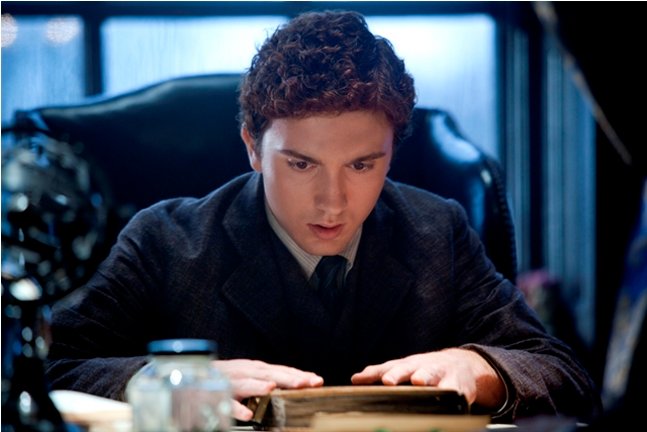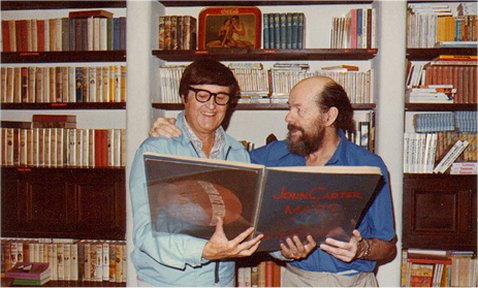
What can you say about a story that just can’t be killed? Is it tenacious? Is it intriguing? How about otherworldly? These are the qualities of Edgar Rice Burroughs’ novel “A Princess of Mars”. Its characters are larger than life (some more than others), its landscape is outlandish and it began a science-fiction/fantasy revolution that spanned a century and helped to inspire Star Wars and Avatar. For years, Hollywood has tried to film this colossal tale, with many famous names, and with no success until today. Teaming with two-time Oscar winner Andrew Stanton, Walt Disney Pictures has finally captured the adventures of John Carter.
 A former US solider, Edgar Rice Burroughs had become a preoccupied writer working for his brother in a stationary company, often taking notes on the very pads the company was making. Burroughs was writing a piece of fiction that he feared others would believe to be made for children. He needed this story to work because he had a wife and two children to support. When he submitted the novel for publishing, Burroughs was paid $400. The book was titled “A Princess of Mars” and he went on to write 10 more novels set in the fictional world of Barsoom. Burroughs would later craft a character that proved to be more popular than “Princess of Mars”, “Tarzan of the Apes”.
A former US solider, Edgar Rice Burroughs had become a preoccupied writer working for his brother in a stationary company, often taking notes on the very pads the company was making. Burroughs was writing a piece of fiction that he feared others would believe to be made for children. He needed this story to work because he had a wife and two children to support. When he submitted the novel for publishing, Burroughs was paid $400. The book was titled “A Princess of Mars” and he went on to write 10 more novels set in the fictional world of Barsoom. Burroughs would later craft a character that proved to be more popular than “Princess of Mars”, “Tarzan of the Apes”. While “Tarzan” was sweeping readers (and soon, decades of movie-goers) off their feet, the world of Barsoom caught the eye of one loony animator. Bob Clampett, the man who helped to invent “Looney Tunes”, came to Burroughs with the notion of turning “A Princess of Mars” into the world’s first feature-length animated film. He wholeheartedly agreed, and work on an animation test began. However, when the test was screened, audiences were “alienated” (pun intended). Clampett stopped development of the project (had it continued, the film might have beaten Snow White and the Seven Dwarfs to theaters) and two decades later, Burroughs passed away.
While “Tarzan” was sweeping readers (and soon, decades of movie-goers) off their feet, the world of Barsoom caught the eye of one loony animator. Bob Clampett, the man who helped to invent “Looney Tunes”, came to Burroughs with the notion of turning “A Princess of Mars” into the world’s first feature-length animated film. He wholeheartedly agreed, and work on an animation test began. However, when the test was screened, audiences were “alienated” (pun intended). Clampett stopped development of the project (had it continued, the film might have beaten Snow White and the Seven Dwarfs to theaters) and two decades later, Burroughs passed away. The book soon landed at Walt Disney Pictures with Terminator producer Mario Kassar in tow. After TRON “failed” to be Disney’s answer to Star Wars, Kassar was convinced this work by Burroughs would compete. Big names soon came attached to the project – Future Pirates of the Caribbean writers Ted Elliot and Terry Rossio, Die Hard director John McTiernan and rising star Tom Cruise. However, McTiernan felt that special effects had not caught up with Burroughs’ vision and the project fell apart. Although the rights returned to Burroughs’ estate, Disney would soon find success in bringing to life the other famous Burroughs creation in 1999’s Tarzan.
The book soon landed at Walt Disney Pictures with Terminator producer Mario Kassar in tow. After TRON “failed” to be Disney’s answer to Star Wars, Kassar was convinced this work by Burroughs would compete. Big names soon came attached to the project – Future Pirates of the Caribbean writers Ted Elliot and Terry Rossio, Die Hard director John McTiernan and rising star Tom Cruise. However, McTiernan felt that special effects had not caught up with Burroughs’ vision and the project fell apart. Although the rights returned to Burroughs’ estate, Disney would soon find success in bringing to life the other famous Burroughs creation in 1999’s Tarzan.
Director Jon Favreau, coming off of Zathura: A Space Adventure, was hired by Paramount Pictures to develop the “Barsoom” series of books into a film adaptation after a previous attempt by Robert Rodriguez and (oddly enough) Ain’t It Cool News creator Harry Knowles had fallen apart miserably following Rodriguez’s departure from the Directors Guild of America. Seeking to faithfully adapt the first three “John Carter” novels, Favreau planned to have the alien race of the Tharks – 15-foot-tall green aliens – filmed with practical effects and makeup. After a year of work, Paramount let the rights lapse, and moved onto reinventing the 40-year-old Star Trek series. As consolation, Favreau was put in charge of a superhero film, which turned out to be Iron Man.

It seemed as though John Carter would never be able to get off the ground on Earth as well he could on Barsoom. That is, until the property was put in the hands of Pixar animator/director Andrew Stanton. After finishing Finding Nemo and Wall•E, Stanton was looking for another project and recalled his love of Burroughs’ John Carter novels. Stanton moved from Pixar to Walt Disney Pictures and asked if Disney could purchase the rights for him. As a reward for the success of Wall•E, Disney agreed. Finally, John Carter entered production in January 2010.
Young Edgar Rice Burroughs (Daryl Sabara) is summoned to his beloved uncle’s mansion. Upon arriving, Burroughs learns that John Carter (Taylor Kitsch) has passed away under mysterious circumstances and is buried in a tomb on the property. Carter’s attorney hands Burroughs a journal that Carter kept and is only to be read by him. Years ago, Carter was an ex-Confederate soldier mining for gold in the Arizona hills until he’s captured by a Union colonel (Bryan Cranston) wanting to use his services. As he’s escaping, Carter stumbles upon a cave filled with gold. Carter suddenly finds himself inexplicably transported to Mars. There he soon becomes entangled in another “Civil War” between the red-skinned people of Helium and Zodanga, is captured by the 15-foot-tall green barbarian warriors the Tharks and finds that he has unnatural strength and agility thanks to the planet’s less dense atmosphere. With allies like Tars Tarkas (Willem Dafoe) and the lovely Helium princess Dejah Thoris (Lynn Collins), Carter will go on an adventure unlike any other.

I thoroughly enjoyed this film. This project started in animation and it took an animation director to bring it to life. Stanton may not get all the praise that fellow Pixar alumni Brad Bird got for his live-action debut, Mission: Impossible – Ghost Protocol, but he does his best here even though the heart of his animated films aren’t here. Another thing that doesn’t help is that there are times in the film where it gets slow and expositional. Taylor Kitsch and Lynn Collins both contribute fine performances. Although his character is featured prominently in the trailers and TV spots, Willem Dafoe’s Tars Tarkas, although a very good use of performance capture, is hardly in the film at all; though he does offer the film a lot of humor. One of the highlights of the film is John Carter’s alien pet companion, Woola. He is just so darn cute that you can’t help but smile when you see him.

For years, Disney has been doing their damndest to replicate the atmospheric success of their Pirates of the Caribbean franchise – from good (The Chronicles of Narnia, National Treasure) to mediocre (The Sorcerer’s Apprentice) to “What were they thinking?” (G-Force, Prince of Persia: The Sands of Time). As I’ve said earlier, Taylor Kitsch and Lynn Collins are good actors, even though their performances sadly bring to mind Jake Gyllenhaal and Gemma Arterton from Prince of Persia: The Sands of Time (a film that I believe was clearly made by the wrong studio; the games aren’t meant to be family-friendly). In fact, the film does have a bad habit of coming off as Prince of Persia “IN SPAAAAAACE!” – a good-looking, athletic outcast with a past he is unwilling to talk about teaming up with a feisty but smart princess to save her kingdom. What helped Pirates achieve box office glory was that there were no expectations for it, save for it being based on a well-known theme park ride (not to mention, a good-looking and talented cast); Disney had already released two other films in the summer of 2003 had Pirates failed – Holes (highly underrated film) and The Lizzie McGuire Movie (the less said about that franchise, the better). Transformers exploded in a similar way in 2007.

I know that all of the Hollywood press machine would have you believe that John Carter is nothing but a no-account failure right from the start. A $250 million budget for a first-time live-action director? Preposterous and reckless, they’d say. They also predicted doom when the film had its initial title “John Carter of Mars” retracted to read simply John Carter after the box office fiasco of Mars Needs Moms (of which I will say it is a decent film). The title does indeed appear at the end of the film, because Stanton says that the character has finally earned his title (of course, many others would say Disney demanded he spin his statement). It’s easy to believe the message of doom and gloom, but I ask you to view the film for what it really is: just an old-fashioned fun space adventure. John Carter puts the frontier in final frontier.
Young Edgar Rice Burroughs (Daryl Sabara) is summoned to his beloved uncle’s mansion. Upon arriving, Burroughs learns that John Carter (Taylor Kitsch) has passed away under mysterious circumstances and is buried in a tomb on the property. Carter’s attorney hands Burroughs a journal that Carter kept and is only to be read by him. Years ago, Carter was an ex-Confederate soldier mining for gold in the Arizona hills until he’s captured by a Union colonel (Bryan Cranston) wanting to use his services. As he’s escaping, Carter stumbles upon a cave filled with gold. Carter suddenly finds himself inexplicably transported to Mars. There he soon becomes entangled in another “Civil War” between the red-skinned people of Helium and Zodanga, is captured by the 15-foot-tall green barbarian warriors the Tharks and finds that he has unnatural strength and agility thanks to the planet’s less dense atmosphere. With allies like Tars Tarkas (Willem Dafoe) and the lovely Helium princess Dejah Thoris (Lynn Collins), Carter will go on an adventure unlike any other.

I thoroughly enjoyed this film. This project started in animation and it took an animation director to bring it to life. Stanton may not get all the praise that fellow Pixar alumni Brad Bird got for his live-action debut, Mission: Impossible – Ghost Protocol, but he does his best here even though the heart of his animated films aren’t here. Another thing that doesn’t help is that there are times in the film where it gets slow and expositional. Taylor Kitsch and Lynn Collins both contribute fine performances. Although his character is featured prominently in the trailers and TV spots, Willem Dafoe’s Tars Tarkas, although a very good use of performance capture, is hardly in the film at all; though he does offer the film a lot of humor. One of the highlights of the film is John Carter’s alien pet companion, Woola. He is just so darn cute that you can’t help but smile when you see him.

For years, Disney has been doing their damndest to replicate the atmospheric success of their Pirates of the Caribbean franchise – from good (The Chronicles of Narnia, National Treasure) to mediocre (The Sorcerer’s Apprentice) to “What were they thinking?” (G-Force, Prince of Persia: The Sands of Time). As I’ve said earlier, Taylor Kitsch and Lynn Collins are good actors, even though their performances sadly bring to mind Jake Gyllenhaal and Gemma Arterton from Prince of Persia: The Sands of Time (a film that I believe was clearly made by the wrong studio; the games aren’t meant to be family-friendly). In fact, the film does have a bad habit of coming off as Prince of Persia “IN SPAAAAAACE!” – a good-looking, athletic outcast with a past he is unwilling to talk about teaming up with a feisty but smart princess to save her kingdom. What helped Pirates achieve box office glory was that there were no expectations for it, save for it being based on a well-known theme park ride (not to mention, a good-looking and talented cast); Disney had already released two other films in the summer of 2003 had Pirates failed – Holes (highly underrated film) and The Lizzie McGuire Movie (the less said about that franchise, the better). Transformers exploded in a similar way in 2007.

I know that all of the Hollywood press machine would have you believe that John Carter is nothing but a no-account failure right from the start. A $250 million budget for a first-time live-action director? Preposterous and reckless, they’d say. They also predicted doom when the film had its initial title “John Carter of Mars” retracted to read simply John Carter after the box office fiasco of Mars Needs Moms (of which I will say it is a decent film). The title does indeed appear at the end of the film, because Stanton says that the character has finally earned his title (of course, many others would say Disney demanded he spin his statement). It’s easy to believe the message of doom and gloom, but I ask you to view the film for what it really is: just an old-fashioned fun space adventure. John Carter puts the frontier in final frontier.